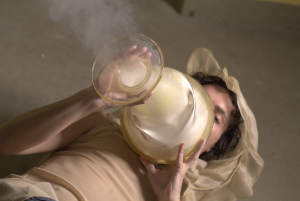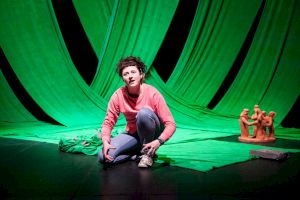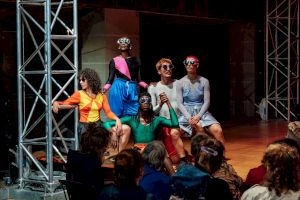PRICE
I Try My Tongue (sequences)
À l’occasion de l’ouverture de l’exposition de Jasmine Gregory au CAPC.
PRICE est un artiste transdisciplinaire jonglant entre la performance, la musique, les arts visuels et la vidéo. Il explore les conditions émotionnelles de la vie contemporaine et les questions d’identité et d’affect à une période où internet a renforcé la domination culturelle de l’image. La voix, élément central de son travail, est considérée comme une forme acoustique de communication émotionnelle, au-delà du langage et de son impératif de signification.
I Try My Tongue pourrait se traduire par « j’essaie ma langue » (langue pouvant être compris comme l’organe mais également la langue maternelle) se déploie comme une performance musicale et chorégraphique improvisée, avec, en son centre, le public. Ici, PRICE parle à celleux dont la langue maternelle n’est pas l’anglais. Comme un enfant, PRICE répète phonétiquement ce qu’iel ne comprend pas. En répétant et en essayant de maîtriser la langue de l’hégémonie iel souhaite montrer que l’enfant emmagasine inconsciemment des signifiants qu’iel ne choisit pas. Il est ici question d’oppression linguistique.
PRICE présente I Try My Tongue (sequences) à l’occasion de l’ouverture de l’exposition de Jasmine Gregory au CAPC.
PRICE, *I Try My Tongue (sequences)* by Stefa Govaart
PRICE measures reality with melody, tonal plasticity and vocal experiment, instead of lyrics. This parking of lyrics in the middle of sung English phonemes deceives the performative force of language. PRICE’s larynx and technological prosthetic are not explicitly owned by words that “don’t come easy”. (1)
This vocal performance pays tribute to those who did not grow up speaking English but were nonetheless bombarded with it. PRICE is a child phonetically repeating what it doesn’t understand. But the child isn’t innocent, it is contaminated from the start. Attempting at becoming proficient in the vocabulary of hegemony, the child is intruded upon by enigmatic signifiers it never chose. Its universe is embedded in an ontology of performance operating wholly inside economies of reproduction. Equivocating between willful performance, enigma and oppression, the child’s inner and outer cannot be resolved through the instantiation of a dialectical synthesis: there is no end to being undone in the act of doing. No poison of true sentiments makes die the evil source of an infection from which sprang the golden idioms and premium syntax that pierce through the child. Causal accounts of sequential determination fail to account for the subject’s emergence. There is no free child that first is and is then, having become an adult, repressed. Repression is not performed by the subject but coincides with its emergence. (2)
If the externalization of the deepest of bodily cavities including the vocal chords is absolute––if the negativity of repression makes you you––then it is the internal contradiction of true sentiments hat PRICE cannot own but can share. (3)
(1) F.R. David, Words Don’t Come Easy (1982).
(2) By insisting that “something concerning sexuality is constitutively unconscious…unconscious even when it first occurs, and not simply due to a subsequent repression,” philosopher Alenka Zupančič shows that repression constitutes (the emergence of) the subject. Alenka Zupančič, What Is Sex? (2015), p.11.
(3) My pressing on the internal contradiction of true––or, free––sentiments via PRICE’s sentimental yet muddled vocals is motivated by thinkers that disinvest from the critical confidence premised on a norm-antinorm logic. There is no dyad capable of enduring the recursive temporality that the historical present urges us to take seriously. At stake here are “the processes through which movements for change are recuperated into the change that does not change—or changes for the worse,” as political theorist Angela Mitropoulos puts it. “Freedom is in unfreedom as the trace of the resistance that constitutes constraint” is a brilliant nondyadic formulation by poet and theorist Fred Moten. In a world built upon the radical exclusion of some that structures the future for all subjects, possibility and impossibility are two sides of the same coin, the Black radical tradition has evidenced time after time. “How might it be thought that there exists a being about which the question of its particular being is the condition of possibility and the condition of impossibility for any thought about being whatsoever?,” scholar Jared Sexton pointedly asks. Angela Mitropoulos, “Art of Life, Art of War: Movement, Un/Common Forms, and Infrastructure” (2018), np; Fred Moten, “Black Optimism/Black Operation” (2007), p.318; Jared Sexton, “The Social Life of Social Death: Afro-Pessimism and Black Optimism” (2011), p.7.
Partenaires





















